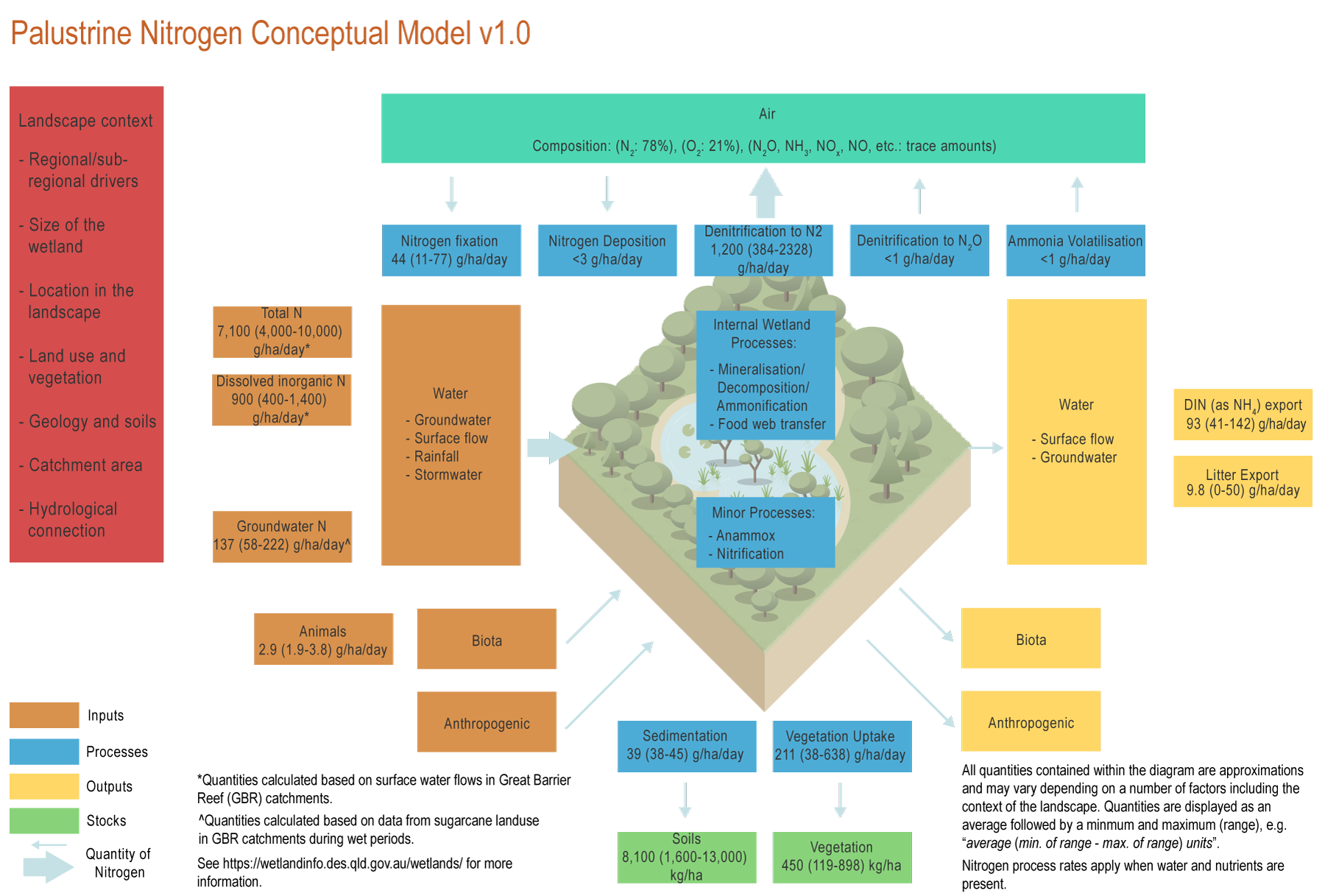|
|
PalustrinePalustrine – Outputs
The conceptual models were compiled by researchers in collaboration with a wide range of stakeholders from Natural Resource Management groups, universities and government agencies and based on available scientific information[4]. Click on elements of the model or select from the tabs below The outputs of nitrogen (N) from a palustrine wetland are dependent on the concentrations of N that enter the wetland, the nature of the palustrine wetland (condition, connection, size etc.), the form of nitrogen (i.e. ammonium (NH4), nitrate (NO3), dissolved organic nitrogen (DON) or particulate nitrogen (PN)), the carbon and N stocks within the wetland, and the rates of processes occurring inside the wetlands (e.g. denitrification, sedimentation, and plant uptake). AirThe denitrification process can account for about 64-70% of nitrogen removal to air from palustrine wetland water and soils[1]. Export of nitrogen as N2O is likely to occur as a result of incomplete denitrification and nitrification. Less than 1% of denitrified N is converted to N2O[2]. Ammonia release is minor, except in highly polluted and anoxic waterways. WaterSurface water and groundwaterOverall N loads exported from palustrine wetlands will be lower than inputs received by wetlands due to the transformations to the air (denitrification), and storage in soils and biota (stocks). During the dry season, outputs of nitrogen from palustrine wetlands are more likely through groundwater flows. In the wet season, large and sporadic pulses of floodwater will transport large amounts of water, and with it, dissolved (93 (41-142) g/ha/day* as NH4) and particulate N[3]. Outputs from groundwater and floodwater are likely to be lower than inputs for dissolved inorganic N (NH4, NO3), and might be higher for dissolved organic N (DON), depending on the productivity of the wetland and the intensity of internal processes (e.g. denitrification, sedimentation, and plant uptake)[7]. Dissolved organic N exports (DON) are also likely to occur in area with highly labile vegetation (e.g. grasses), especially if it is senescent, or if it undergoes drying and rewetting[6]. Vegetated litterLitter comprising leaves, twigs and bark is exported during the wet season at a rate of 9.8 (0-50) g/ha/day*. Litter fall export tends to be seasonal, with increased leaf litter in the dry season, and increased litter export during large floods[3]. The amount of litter as N exported from a wetland is associated with its productivity. BiotaLocalised and temporary populations of birds can remove a significant amount of nitrogen from a wetland, particularly in breeding events[4][5]. Macrophytes can be flushed out of the lakes during flooding events, when most of the biomass can be exported during strong rainfall events. AnthropogenicHarvesting of trees, reeds, and fish, or removal of weeds can remove nitrogen from wetlands. *Nitrogen quantities are displayed as an average followed by a minimum and maximum (range), e.g. “average (min. of range - max. of range) units”. References
Last updated: 31 July 2021 This page should be cited as: Department of Environment, Science and Innovation, Queensland (2021) Palustrine – Outputs, WetlandInfo website, accessed 8 May 2025. Available at: https://wetlandinfo.des.qld.gov.au/wetlands/ecology/processes-systems/nitrogen-concept-model/palustrine/outputs.html |

 — Department of the Environment, Tourism, Science and Innovation
— Department of the Environment, Tourism, Science and Innovation

